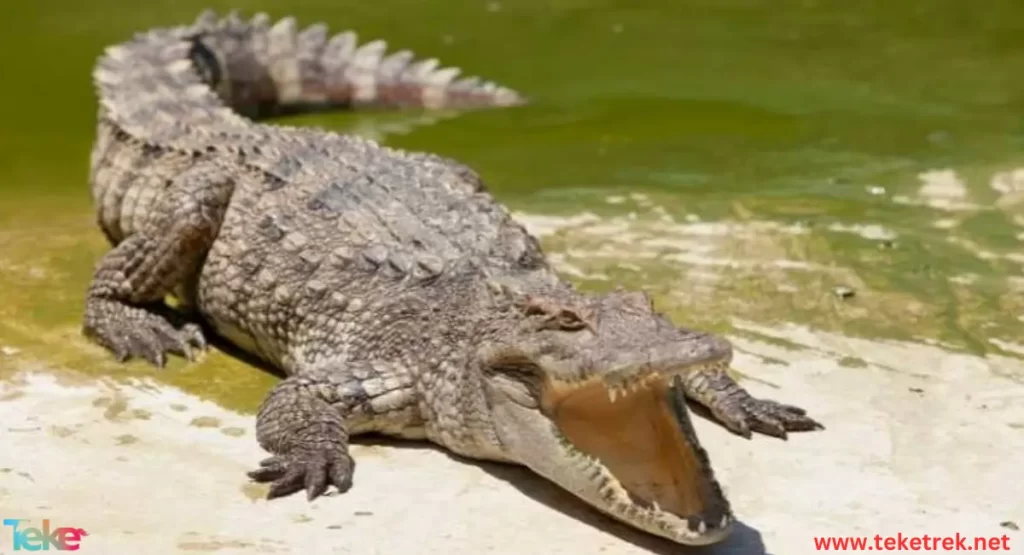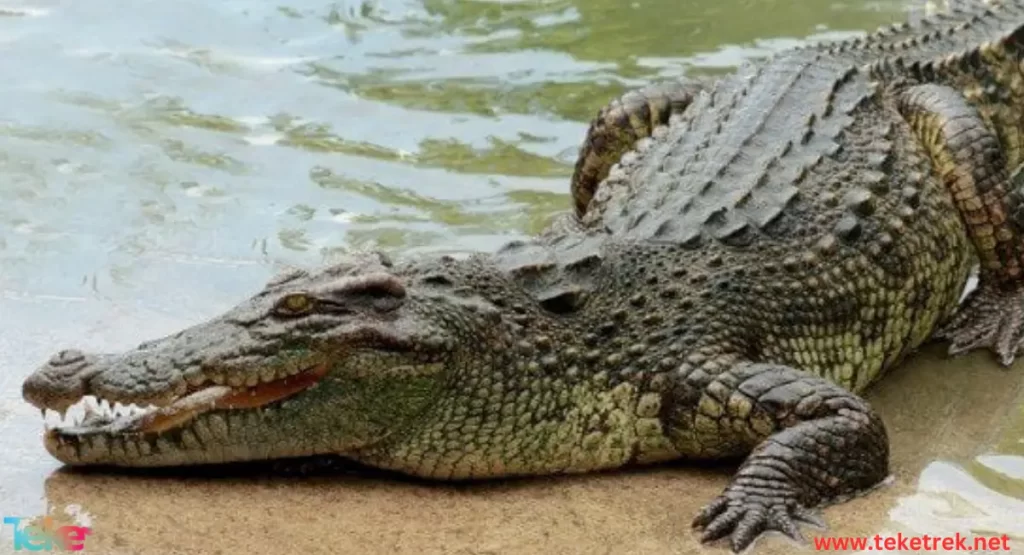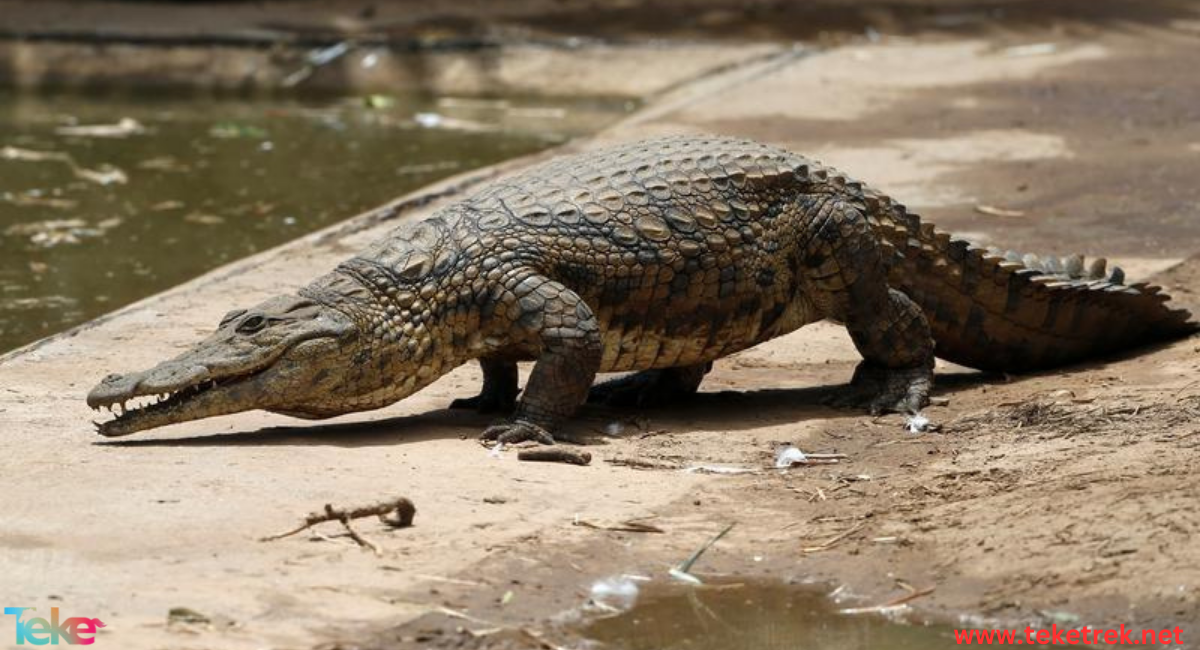The crocodile is earer of the legend of fake tears and one of the oldest creatures on Earth, it is a species that struggles for survival and existence.
Let’s learn more about it from teketrek.

Key information about crocodiles:
Scientific name: Crocodylidae
- Belongs to the Crocodylidae family or “Archosaurs” and is one of the largest reptiles at the top of the predator chain.
It inhabits rivers and swamps, with crocodiles mainly found in tropical regions.
They also inhabit wetlands, lakes, and some saline water areas.
The crocodile was found in the Americas, Africa, Australia and Asia.
There are multiple species of crocodiles, with up to 14 known species.
- The average lifespan of a crocodile is between 35 to 50 years.
Crocodile shape and recipes
Crocodiles have a long and massive body with thick skin and short but powerful legs. They also possess a long tail that aids in swimming.
They are quadrupedal animals, relying on crawling to move from one place to another.
Their bodies are covered in scales made of armored plates that resist water, keeping them hydrated and protecting them from other predators.
The colors of a crocodile’s scales vary between green, black, brown, and gray, allowing them to camouflage among plants and in the water while stalking prey.
Their external nostrils are close together, aiding in breathing outside water while swimming.
Crocodiles have ears covered with a membranous skin to protect them from water.
They have upper and lower jaws, each containing a large number of sharp teeth used to grasp prey. They have about a hundred teeth in each jaw and a thick tongue tightly connected to the floor of their mouth.
Crocodiles possess strong senses, including large eyes with vertical pupils that narrow in bright light and widen in darkness.
They also have a strong sense of hearing, with external flaps protecting their ears from water.
Their sense of smell is highly developed, and they also have senses of touch and taste.
Crocodiles are among the largest reptiles alive, with adults reaching lengths of about 23 feet and weights of up to 5000 kg.
Crocodile Diet:
Crocodiles are strictly carnivorous, feeding on fish, birds, frogs, crustaceans, rodents, and even attacking humans. They stalk their prey and, when the opportunity arises, use their powerful tail to propel towards it, capturing it with their massive jaws and swallowing it whole since they lack the ability to chew or tear like other animals. crocodiles can live a few months without food.
Crocodile Reproduction:
- Female crocodiles lay from 12 to 48 eggs each time, depending on their age, size, and species. Each egg weighs between 50 to 160 grams.
- The incubation period of the eggs ranges from 55 to 100 days. The gender of the embryo is determined by the temperature of the egg during the first half of the incubation period. Eggs incubated at cooler temperatures produce females, while those at warmer temperatures produce males.
- After two or three months of laying the eggs, the hatchlings are ready to emerge. The female removes debris and debris from the eggs and helps the hatchlings reach the water.
- The female usually stays close to her offspring and provides protection from predators for several weeks to months until they grow older.
- Crocodiles hide their eggs in nests made of plants or bury them in sand on beaches.
- Hatchling crocodiles feed on crustaceans and insects found near rivers or lakes.
Benefits of Crocodiles to the Environment:
Crocodiles possess an immune digestive system that is resilient against bacteria, viruses, and microbes, and their extinction could devastate the ecosystem. Their skins are utilized in the manufacturing of products such as handbags and shoes. Their meat serves as a food source in some countries, constituting a traditional diet in Australia, Thailand, Vietnam, and South Africa, and a delicacy in the West.
Crocodile Species:
- American Crocodile: Found in North and South America, it is among the large-sized crocodiles. It can reach up to 6 meters in length and weigh up to 907 kilograms. It may also threaten people’s lives.
- Narrow-Snouted Crocodile: Found in Africa, it is small-sized, reaching up to 2.49 meters in length, and weighing between 125 to 325 kilograms. It is an endangered species due to habitat loss and overhunting.
- Orinoco Crocodile: One of the largest crocodiles in the Americas, it is also one of the most aggressive, reaching up to 3.96 meters in length.
- Freshwater Crocodile: Light brown in color, it is found in Australia and feeds on fish and small vertebrates.
- Philippine Crocodile: Golden brown in color, it can reach up to 3.02 meters in length.
- Morelet’s Crocodile: Lives in Guatemala, Belize, and Mexico, feeding on reptiles, birds, and mammals. It is less dangerous than other crocodile species.
- Nile Crocodile: Found in Africa, the Nile Basin, and Madagascar, it poses a threat to human life. It can reach up to 6 meters in length and weigh up to 748.42 kilograms.
- New Guinea Crocodile: A small-sized species that feeds on mammals and small fish.
- Sewer Crocodile: Sneaks through tunnels under major city streets and feeds on small animals and even garbage.
- Saltwater Crocodile: The most dangerous crocodile species on land, reaching up to 6.09 meters in length. It is prominently found in the Indian subcontinent, Australia, and Southeast Asia.
- Cuban Crocodile: Capable of leaping out of the water to catch prey such as birds and mammals on branches of nearby trees. It is currently one of the rare species.
- Siamese Crocodile: Rare and found in small numbers in Cambodia, Indonesia, Laos, Thailand, and Vietnam.
- West African Crocodile or Desert Crocodile: One of the most dangerous and aggressive crocodiles, directly found in Africa.
- Dwarf Crocodile: Capable of climbing trees in search of prey and often seen swimming with its eyes and nostrils above water to monitor its surroundings. Dwarf crocodiles can live more than 75 years.
Strange Facts About Crocodiles:
Crocodile tears are said to be fake, as they are not genuine tears. They shed tears from their eyes while eating, as air and food remnants enter the lacrimal glands, causing tears to flow.
Crocodiles spend most of their time swimming, as they are cold-blooded animals and come out onto land to seek warmth during daylight hours.
Crocodiles are curious reptiles with high intelligence and quick learning abilities.
During cold months, crocodiles enter a state of dormancy after digging themselves a suitable place.
Crocodiles keep their mouths open because they struggle to align the upper jaw teeth with the lower jaw teeth when closing their mouths.
Crocodiles sleep with one eye open to explore surrounding dangers or prey.
Unlike many other reptiles, crocodiles can regenerate parts of their bodies, such as skin and bones. They regularly shed their skin, consuming it afterward. When he loses a tooth, he quickly replaces it, so that he can replace 8,000 teeth during his lifetime.
Despite their large size and weight, crocodiles can swim at speeds of up to 32 kilometers per hour, making them proficient predators in water. Additionally, they can hold their breath underwater for up to an hour.
Crocodiles are long-lived creatures, with lifespans of up to 70 years or more in the wild.

Common Questions:
- Do crocodiles lay eggs or give birth ?
Crocodiles lay eggs and do not give birth. This is the reproductive method for most reptiles, including crocodiles. After laying eggs, the hatchlings emerge as fully formed baby crocodiles ready to live in the aquatic environment.
- How fast can a crocodile move on land?
Crocodiles move relatively slowly on land. Typically, a crocodile’s speed on land is about 1.5 to 2 miles per hour (approximately 2.4 to 3.2 kilometers per hour).
- What is the lifespan of a crocodile on land?
The lifespan of a crocodile varies depending on its species and the environmental conditions it lives in. Generally, crocodiles can live for a long time, exceeding 50 years in the wild.
- What does crocodile eat?
Crocodiles primarily eat fish, amphibians, birds, and mammals, including deer, monkeys, and domestic animals like livestock. They are opportunistic predators and will consume almost anything that comes within their reach, including carrion.
- What is the largest crocodile in the world?
The largest crocodile on record is a saltwater crocodile named “Lolong.” He measured 6.17 meters (20 feet 3 inches) in length and weighed 1,075 kilograms.
- What country has the most crocodiles?
Australia is known to have one of the highest populations of crocodiles in the world, particularly saltwater crocodiles (Crocodylus porosus).
- Is the crocodile aquatic?
The crocodile is indeed an aquatic animal. It belongs to the Crocodylidae family and inhabits both freshwater and saltwater environments, such as rivers, lakes, swamps, and other bodies of water. The crocodile possesses a sturdy, muscular body with short legs and a long tail, enabling it to swim effectively in water. Despite its aquatic lifestyle, it ventures onto land for basking, thermoregulation, or hunting.
In conclusion, although crocodiles may evoke fear at first glance, they remain unique, fascinating, and remarkable animals embodying strength and mystery. They carry a long history of evolutionary attempts and adaptations from the surrounding environment.





